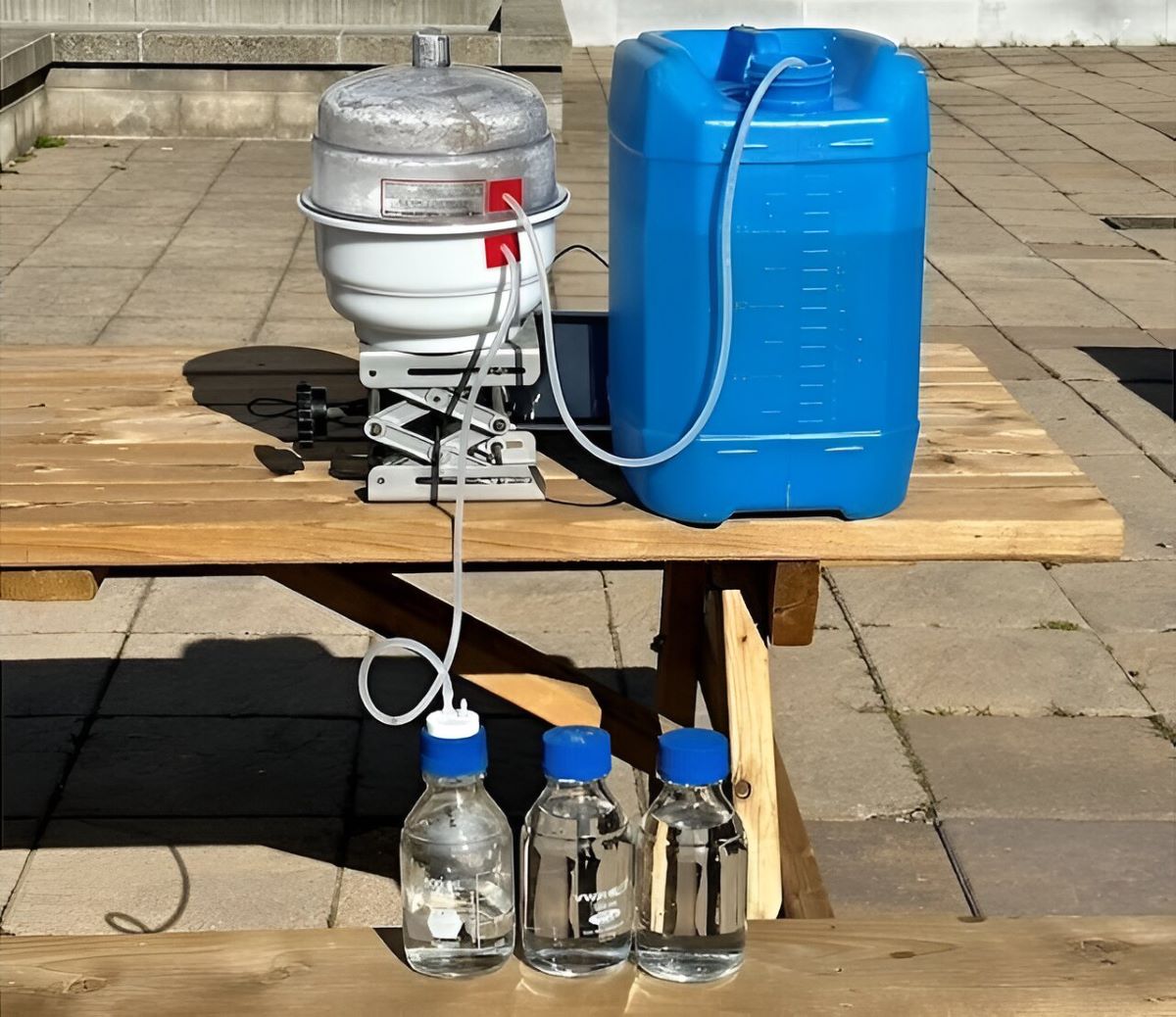
Researchers at the University of Waterloo have designed an energy-efficient device that produces drinkable water from seawater using an evaporation process powered primarily by solar energy.
Highlights:
- Uses sunlight to heat seawater.
- Heated water rises through special materials.
- Water evaporates and turns into vapor.
- Salt remains below, preventing device clogging.
- Vapor cools and turns into clean water droplets.
- Freshwater is ready to drink, with no salt.
- Operates without electricity, relying solely on solar energy.
- Ideal for coastal areas with limited access to freshwater.
Energy-Efficient Device Uses Solar Power to Turn Seawater Into Drinking Water
Desalination is crucial for many coastal and island nations, providing access to freshwater in regions where water scarcity is a growing concern. With the global population increasing rapidly and water consumption rising, the demand for new technologies to generate freshwater is becoming more urgent.
According to the United Nations World Water Development Report 2024, approximately 2.2 billion people worldwide lack access to clean water, highlighting the need for innovative technological solutions to supply freshwater sustainably.
Limitations of Conventional Desalination Systems
Current desalination systems often use membranes to separate salt from seawater. However, this process requires large amounts of energy and often leads to salt buildup on the surface of the devices, blocking water flow and reducing efficiency. As a result, these systems require frequent maintenance and cannot operate continuously.
Nature-Inspired Solution: The Waterloo Innovation
To overcome these limitations, researchers at the University of Waterloo drew inspiration from the natural water cycle, emulating how trees transport water from their roots to their leaves. They developed a device that allows continuous desalination without intensive maintenance. This breakthrough was published in the journal Nature Communications.
According to Professor Michael Tam from the Department of Chemical Engineering at Waterloo, the system is based on the observation of how nature supports the water cycle, enabling water to evaporate and condense in a closed loop. This prevents salt accumulation, which decreases efficiency in other systems.
Technical Innovations of the Device
The device is solar-powered and has a conversion rate of 93%, making it five times more efficient than current desalination systems. It can produce approximately 5.3 gallons of potable water per 10.7 square feet (20 liters per square meter) per day, which aligns with the World Health Organization (WHO) recommendation for basic daily consumption and sanitation needs.
The innovative device is made with nickel foam coated with a conductive polymer and heat-responsive pollen particles. This material absorbs sunlight across the full solar spectrum, converting the sun’s energy into heat. A thin layer of saltwater on the polymer heats up and is transported upwards, replicating the capillary process seen in trees.
As the water evaporates, the remaining salt moves to the lower layer of the device in a process similar to backwashing in pools, preventing water flow blockage and enabling continuous operation.
Benefits and Future of the Device
Professor Yuning Li, also from the Department of Chemical Engineering at Waterloo, emphasized that the device is not only efficient but also portable, making it an ideal tool for use in remote regions with limited access to drinking water. This technology offers a sustainable solution to the emerging global water crisis.
In the future, researchers plan to build a prototype that can be deployed at sea to test the technology on a larger scale. If successful, the device could provide a sustainable supply of freshwater to coastal communities, contributing to the achievement of the United Nations Sustainable Development Goals (SDGs), particularly in the areas of health (SDG 3), access to water (SDG 6), reducing inequalities (SDG 10), and responsible consumption and production (SDG 12).
Global Impact
The application of this technology could transform the lives of millions of people in water-scarce regions, particularly in coastal and remote areas where water infrastructure is limited. By relying primarily on solar energy, the device is not only energy-efficient but also a more sustainable and accessible alternative for the future of desalination on a global scale.
Moreover, its ability to operate without frequent maintenance makes it a viable and cost-effective option, favoring its implementation in communities with limited resources. As it scales up and is tested in real-world conditions, this innovation promises to significantly address global challenges related to access to clean water.
This development underscores how scientific research and technological innovation, inspired by natural processes, can offer tangible solutions to the most pressing problems of our time, aligning with global efforts to ensure a more sustainable and equitable future.
Source: University of Waterloo
Advantages of the University of Waterloo Desalination Device:
- High energy efficiency: The device has a 93% conversion rate, making it five times more efficient than conventional desalination systems.
- Solar-powered: The device runs on solar energy, making it sustainable and reducing reliance on fossil fuels.
- Sufficient daily production: It can generate up to 5.3 gallons (20 liters) of potable water per 10.7 square feet (1 square meter) per day, meeting the WHO’s basic daily water requirements.
- Portability: The device is compact and portable, ideal for use in remote regions with limited access to potable water.
- Reduced maintenance: Its design prevents salt buildup, reducing the need for frequent maintenance.
- Scalability potential: The device could be implemented in coastal areas and tested at sea, increasing its scalability.
- Cost-effective technology: The use of simple yet innovative materials makes it a financially viable option for communities with limited resources.
- Contributes to the SDGs: The technology has the potential to impact several UN SDGs, including access to clean water, reducing inequalities, and responsible consumption.
Disadvantages of the Device:
- Weather-dependent: Its solar-based operation may be less effective on cloudy days or in regions with low solar radiation.
- Limited production for industrial needs: While suitable for household use, the device is not yet viable for meeting the large water demands of industries or agriculture.
- Still in development: The device is currently in the research phase and has yet to be tested on a large scale, meaning it could face challenges in mass implementation.
- Initial costs: Despite its economic potential, the initial development, manufacturing, and distribution costs remain unclear and could be a barrier to immediate adoption in some regions.
- Durability in marine environments: Although the device will be tested in real-world conditions, its long-term resistance to harsh marine environments, such as saltwater and corrosion, has yet to be determined.



















